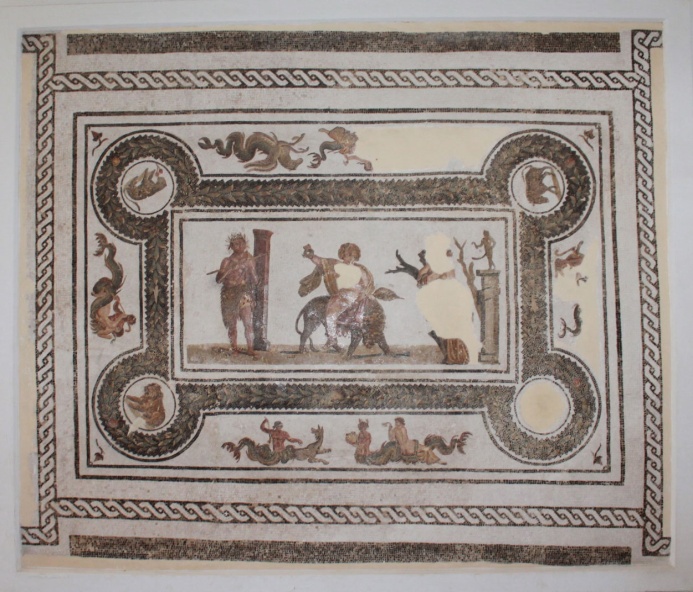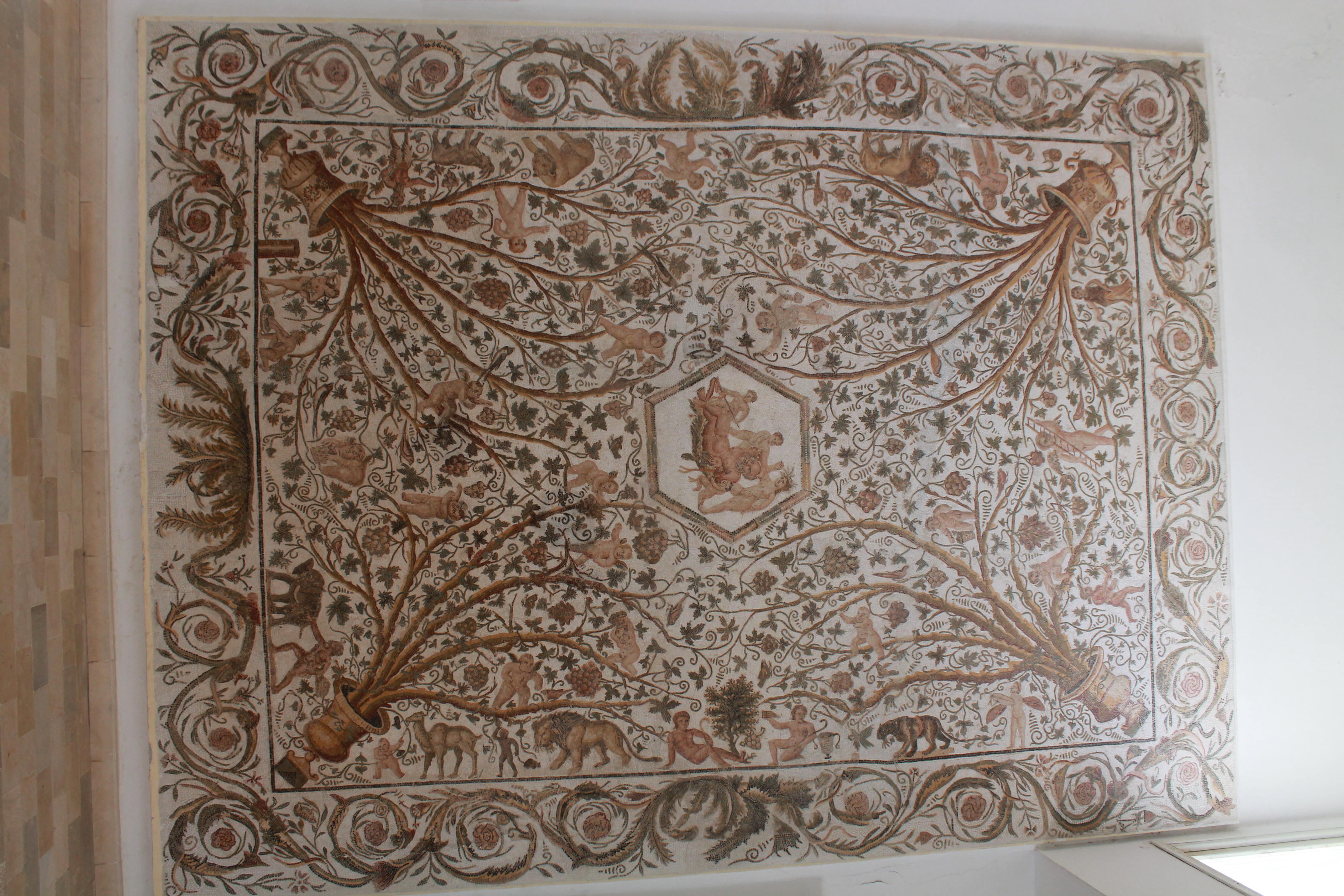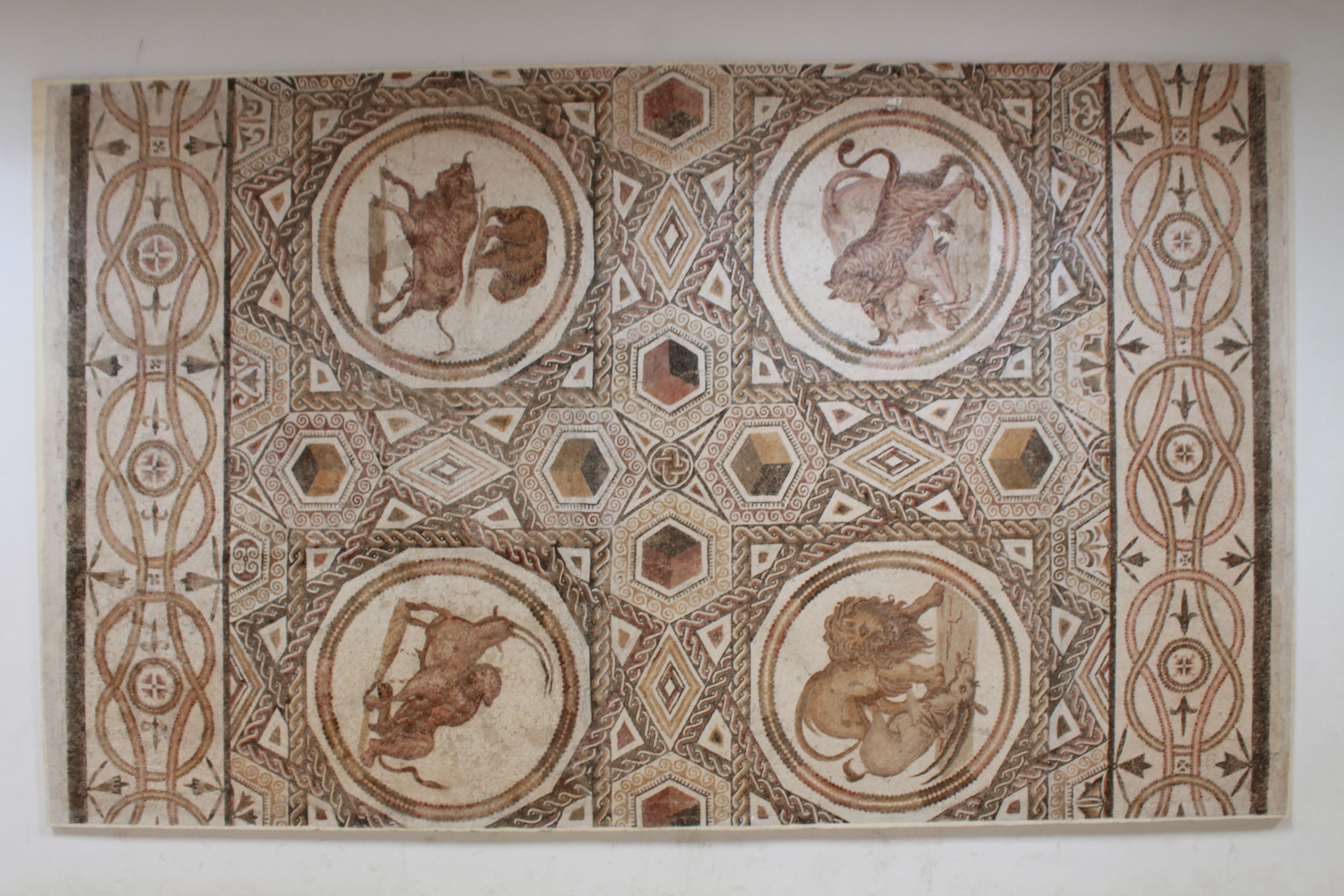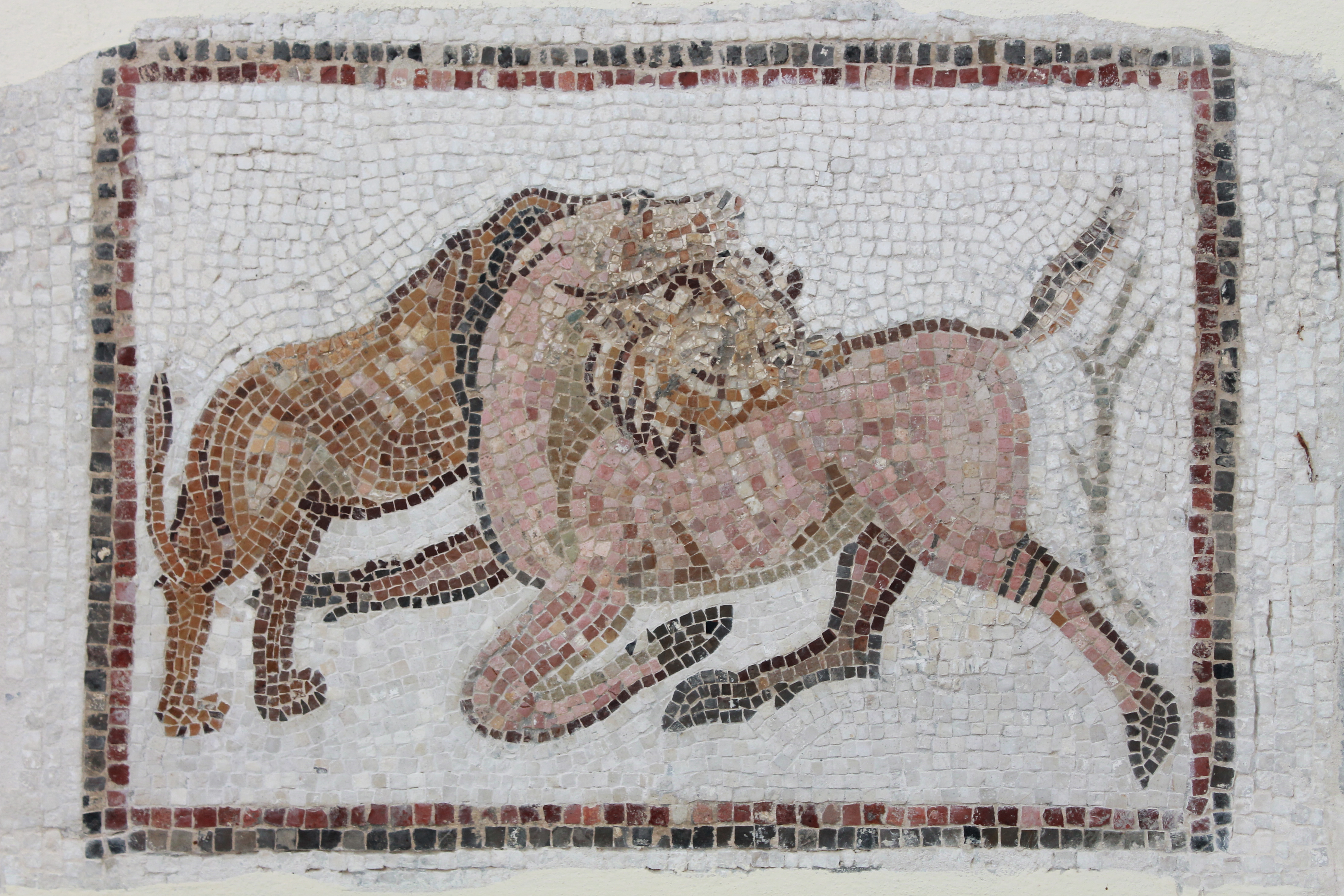A Virtual Tour of the El Jem Museum

فسيفساء حنية تصور طاووسا نافخا ريشه و بجانبيه فتيين مجنحين يحمل كل منهما مشعلا طويلا. القرن الثاني الميلادي. القرن الثاني و الثالث الميلادي. دار الطاووس . Mosaïque d’abside représentant un paon faisant la roue flanqué de deux Amours ailés tenant, chacun, un long flambeau. IIIè.s.ap.J.C. II è et IIIè.s.ap.J.C. Maison du Paon Apsidal mosaic representing a peacock spreading its tail between two winged angels holding a long candlestick each. 3rd c.A.D. 2nd and 3rd c.A.D Maison du Paon.

فسيفساء تمثل خمسة اطر مستديرة في كل واحد منها سمكة يعلوها عمود و هو شعار جمعية البنتازيي. و كانت هذه الجمعية _ الى جانب جمعيات اخرى (التيليقاني و السنيماتي)- تنظم عروضا بالملعب المدرج. القرن الثالث الميلادي. الحمامات الصغرى بارض مبارك رحيم. Mosaïque de seuil figurant, dans cinq médaillons, cinq poisons surmontés de cinq barres. Il s’agit de l’emblème de la sodalité des Pentasii, comme les Telegenii ou les Sinematii etc. étaient de puissantes associations qui organisaient les spectacle à l’amphithéâtre. III è.s.ap.J.C Les Petits Thermes du terrain M’barek Rhaiem. Doorstep mosaic representing five fishs surrrounded by bars in five medallions. It is the emblem of coporation of the Pentasii. The Pentasii, like the Telegenii or the Sinematii etc were powerful associations that organized the shows. 3rd c.A.D Les Petits Thermes du terrain M’barek Rhaiem.

الاه السنة محاط بالفصول الاربعة. منتصف القرن الثاني الميلادي. دار موكب ديونيزوس. Le génie de l’année entouré des saisons de quatre saisons. Milieu II è.s.ap.J.C. Maison de la Procession dionysiaque. The genious of the Year surrounded by the four Seasons. Middle of 2nd c.A.D Maison de la Procession dionysiaque.

فسيفساء ذات مشاهد مختلفة منها احكام ربط سيلان ، وهو عجوز مخمور من اتباع ديونيزوس ، نراه مستلق على فراش من اوراق الشجر و حوله (ثلاثة) اطفال يحاولون شد يديه و رجليه بإكليل من الازهار و الالهة اقلي موبخة توجه نحوه يدها اليمنى. و في الزوايا، نرى نواجيد تنبق منها دالية محملة عناقيد عنب و اوراقا متشابكة بداخلها فتيان يجنون العنب و اسدا و لبوة و جملا و البطل هرقل يحاول تهدئة فيل هائج و حلزونا و فارا و عصافيرا عديدة. القرن الثالث الميلادي. دار سيلان. Mosaïque figurant des scènes multiples : ligotage de Silène, vieillard ivre en permanence, (allié de Dionysos) qu’on voit au milieu du tableau étendu sur un lit de feuillage. Autour de lui, trois enfants essayent de lui attacher les mains et les pieds avec une guirlande de fleurs tressées. Eglé , d’un geste autoritaire, lève la main droite en direction de Siléne. Aux quatre angles , sont représentés des cratères d’où s’échappent des ceps de vigne chargés de raisins et un feuillage confus à l’intérieur desquels on voit des Amours vendangeurs, un lion, une lionne, un chameau, Hercule calmant un éléphant furieux, un escargot , une sauterelle, un rat et de multiples oiseaux IIIè.s.ap.J.C Maison de Silène. Mosaic representing multiple scenes: tying up of Silenus, a permanently-drunk old man, whom we see in the middle of the picture, lying on a leaf-bed. Around him, three kids-children are trying to live together his hands and feet with a garland of wreathed flowers. Egle, with an authoritarian gesture, raises his right hand towards Silenus. At the four angles are represented craters out of which vine plants loaded with grapes and a foliage inside which we see grape-picking Angels, a lion, a lioness, a camel, Hercule calming down furious elephant, a snail, a grasshopper, a rat, a lizard and many birds. 3rd c.A.D Maison de Silène.

جزء من فسيفساء تصور رنا (خنزيرا) و ايلة داخل اطارين. اواخر القرن الثالث الميلادي. دار سيلان. Fragment de mosaïque renfermant, dans des médaillons, un sanglier et une biche. Fin III è.s.ap.J.C Maison du Silène Fragment of mosaic containing a boar and a hind in medallions. End of 3rd c.A.D Maison du Silène

الالاه ديونيزوس صبيا راكبا صهوة نمرة و تحيط به في الزوايا رموز الفصول الاربعة. القرن الثاني الميلادي. دار موكب ديونيزوس Dionysos, enfant chevauchant une tigresse. Dans les angles sont représentés des végétaux symbolisant les quatre Saisons. II è.s.ap.J.C Maison de la Procession dionysiaque. Child Dionysus riding a tigress. Plants symbolizing the four Seasons are represented in the angles. 2nd c.A.D Maison de la Procession dionysiaque.

فسيفساء تمثل خمسة اطر مستديرة في كل واحد منها سمكة يعلوها عمود و هو شعار جمعية البنتازيي. و كانت هذه الجمعية _ الى جانب جمعيات اخرى (التيليقاني و السنيماتي)- تنظم عروضا بالملعب المدرج. القرن الثالث الميلادي. الحمامات الصغرى بارض مبارك رحيم. Mosaïque de seuil figurant, dans cinq médaillons, cinq poisons surmontés de cinq barres. Il s’agit de l’emblème de la sodalité des Pentasii, comme les Telegenii ou les Sinematii etc. étaient de puissantes associations qui organisaient les spectacle à l’amphithéâtre. III è.s.ap.J.C Les Petits Thermes du terrain M’barek Rhaiem. Doorstep mosaic representing five fishs surrrounded by bars in five medallions. It is the emblem of coporation of the Pentasii. The Pentasii, like the Telegenii or the Sinematii etc were powerful associations that organized the shows. 3rd c.A.D Les Petits Thermes du terrain M’barek Rhaiem.

جزء صغير يمثل مشهد رقص لخلان ديونيزوس : سواتير و باكنتا و الى جانبهما طاووس. القرن الثالث الميلادي. دار سيلان. Petit fragment de mosaïque représentant les concubines de Dionysos, Satyres, Baccante et Pan un paon exécutant un pas de danse. III è.s.ap.J.C Maison du Silène Small Fragment of mosaic representing Satyrs, Bachanta and peacock performing a dancing step. 3rd c.A.D Maison du Silène.

فسيفساء تصور ريش طاووس. القرن الثاني الميلادي. دار مركب دونيزوس Plumes de paon. II è.s.ap J.C Maison de la Procession dionysiaque. Peacock feathers 2nd c.A.D Maison de la Procession dionysiaque.

الهات الفنون السبعة وهن كليو الهة التاريخ و اورانيا الهة الفلك و ملبومان الهة المسرح الماساوي و تالي الهة المسرح الهزلي و تاربسيكور الهة الرقص و كاليوبا الهة الشعر الملحمي و ايراتو الهة الشعر الغزلي و بوليمني الهة الغناء الديني و البلاغة و اوتربا الهة الشعر الهزلي و الموسيقى. النصف الثاني من القرن الثالث الميلادي. دار اشهر السنة. Les neufs Muses accompagnées de leurs attributs : Clio muse de l’histoire ; Uranie celle de l’astronomie ; Melpomène la tragédie ; Thalie la comédie ; Terpsichore la danse ; Calliope la poésie épique ; Erato la poésie érotique ; Polymnie présidait aux chants religieux et à la rhétorique ; Euterpe à la poésie lyrique et à la musique The nine Muses with their attributes : Clio muse of history ; Uranie that of astronomy ; Melpomene,tragedy ; Thalie,comedy; Terpsichore,dancing ; Calliope,the epic poetry ; Erato, love poetry ; Polymnie presiding over religious songs and rhetoric ; Euterpe the lyric poetry and music. 2nd half of 3rd c.A.D Maison des Mois. فسيفساء تصور ريش طاووس.

جزء من فسيفساء عتبة تمثل ناجودا تتفرع منه دالية. اواخر القرن الثالث الميلادي. دار ارفيوس. روقا. Bande de mosaïque de seuil représentant un cratère d’où sortent des ceps de vigne. Fin II è s.ap.J.C Maison d’Orphée Rougga. Strip of doorstep mosaic representing a crater out of which vine plants loaded. End of 2nd c.A.D Maison d’Orphée. Rougga.

فسيفساء حنية ازدان اعلاها بمثلثات منظمة في شكل مروحي و اسفلها بأغصان عنب. القرن الثالث الميلادي. دار بارض الحاج فرجاني قاسم. Mosaïque d’abside figurant des triangles multicolores déployés en éventail et des rinceaux de vigne. III é.s.ap-J.C Maison du terrain Haj Ferjani Kacem Apsidal mosaic representing multicoloured triangles displayed in a fan shape and vine foliated scrolls. 3rd c.A.D. Maison du terrain Haj Ferjani Kacem.

جزء صغير من فسيفساء يمثل اجاصا. القرن الثالث الميلادي. دار سيلان. Petit fragment de mosaïque représentant des poires. III é.s.ap.J.C Maison du Silène Small fragment of mosaic representing pears. 3rd c.A.D Maison du Silène.

اطاران تفصل بينهما رسوم نباتية لم يبق منهما إلا واحد يحتوي على سمكة. القرن الثالث الميلادي. ارض الجيلاني قيراط. Médaillons occupés l’un, par un poisson, l’autre est détruit. L’espace entre les deux médaillons présente un motif végétal. IIIè.s.ap.J.C Terrain JilaniGuirat. Medallions occupied one of a fisch, the other is destroyed. The space between the two medallions presents a plants pattern. 3rdc.A.D Terrain Jilani guirat (Guirat)

فسيفساء تمثل صراع ديكين لم يبق منها سوى جزء الديك المهزوم و صاحبه. النصف الثاني من القرن الثاني ميلادي. دار ترتولا، (ارض عمر عباس.) Fragment de mosaïque représentant un combat de coqs. Seuls subsistent le coq vaincu et son propriétaire. Deuxieme moitié du II è s.ap.J.C Maison Tertulla,) terrain Amor Abbes( Fragment of mosaic representing a cock fight. Remaining only the defeated cock and his owner. 2nd half of 2ndc.A.D Maison Tertulla,) terrain Amor Abbes.(

جزء من فسيفساء تمثل شخصيات و يرمز هذا الجمع لعربة نصر الاه الخمرديونيزوسمرفوقا بخلانه منهم ساتير يحمل مشعلا. القرن الثالث الميلادي. دار ترتولا، )ارض عمر عباس.( Fragment de mosaïque représentant le triomphe de Bacchus , dans le cortège un personnage ailé , deux Satyres dont un tenant un flambeau. III è.s.ap.J.C Maison de Tertulla, (terrain Amor Abbes.) Chip of mosaic representing the triumph of Bacchus, in the procession a winged personage, tow Satyrs one of whom holding a torch. 3rdc.A.D Maison de Tertulla ,(Terrain Amor Abbes)

ساتير بيده ثعبانا يطارد باكنتا منزعجة. اواخر القرن الثاني الميلادي. دارA بارض جيلاني قيراط Satyre tenant un serpent et poursuivant une Bacchante effrayée. Fin II è.s.ap.J.C Maison A du terrain Jilani Guirat Satyr (holding a serpent and) pursuing a frightened Bacchanta. End of 2ndc.A.D Maison A du terrain Jilalni Guirat.

عدة اطر تجسم ازهارا صليبية الشكل و اقنعة و حيوانات و ثمارا. القرن الثالث الميلادي. )ارض جيلاني قيراط.( Médaillons renfermant des fleurs cruciformes, des masques, des animaux et des fruits. III è s.ap.J.C (Terrain Jilani Guirat.) Medallions containing cruciform flowers, masks, animals and fruits. 3rd c.A.D. (Terrain Jilani Guirat.)

جزء من فسيفساء تمثل باكنتا-وهي من خليلات الاه الخمر ديونيزوس- ... (محاطة بأغصان التين) ماسكة طبلا و مزراقا. القرن الثالث الميلادي. ارض جيلاني قيراط. (دار ترتولا، ارض عمر عباس) Fragment de mosaïque représentant une Bacchante –concubine de Dionysos- -- au milieu de sarments de vigne tenant un tambourin et un thyrse. IIIè.s.ap.J.C Maison de Tertulla (, terrain Amor Abbes). Chip of mosaic representing a Bacchanta holding a tambourine and thyrse. 3rdc.A.D Maison de Tertulla (, terrain Amor Abbes).

جزء من فسيفساء تمثل امرأة مسنة ترمز لفصل الشتاء. اوائل القرن الثالث الميلادي. حي بئر زيد Fragment de mosaïque figurant une femme âgée symbolisant l’Hiver. Debut III è S.ap.J.C Quartier Bir Zid. Fragment of mosaic representing an old women symbolizing Winter. Early of 3rdc.A.D Quartier Bir Zid.

فتى مجنح يجني عنبا. القرن الثاني الميلادي. (حي بئر زيد ) مجهولة المصدر . Amour vendageur. IIè.s.ap.J.C Provenance inconnu (Quartier Bir Zid.) Grape-picking Angel 2ndc.A.D Incertaine origin (Quartier Bir Zid.)

جزء من فسيفساء تصور مشاهد تتعلق بنهر النيل :طيور متنوعة و اقزام يتعاطون نشاطات مختلفة. القرن الثالث الميلادي. حي بئر زيد. Mosaïque nilotique représentant des oiseaux et des pygmées s’adonnant à des activités diverses. II ès.ap.J.C) III ès.ap.J.C( Quartier Bir Zid. Nilotic mosaic representing birds and pigmies busy with various activities. 2ndc.A.D (3rdc.A.D) Quartier Bir Zid.

جزء من فسيفساء تصور مشاهد تتعلق بنهر النيل :طيور متنوعة و اقزام يتعاطون نشاطات مختلفة. القرن الثالث الميلادي. حي بئر زيد. Mosaïque nilotique représentant des oiseaux et des pygmées s’adonnant à des activités diverses. II ès.ap.J.C) III ès.ap.J.C( Quartier Bir Zid. Nilotic mosaic representing birds and pigmies busy with various activities. 2ndc.A.D (3rdc.A.D) Quartier Bir Zid.

الهة الفجر تغازل سيفال ، ابن ارميس ،. ابلون يغازل سيرانا. ابلون يطارد دافني (، الحورية التي يحبها.) اواخر القرن الثاني الميلادي. دار Aبارض جيلاني قيراط. Aurore séduisant Céphale, fils d’Hermés. Apollon attirant Cyrène. Apollon poursuivant Daphné, nymphe dont il était amoureux. Fin II è.s.ap.J.C Maison A du terrain JilaniGuirat. Aurore enticing Cephale, son of Hermes. Apollo enticing Cyrene. Apollo pursuing Daphne, nymphe (nymph) loved by him. End of 2ndc.A.D Maison A du terrain Jilani Guirat

عرض مصارعة بين حيوانات بالملعب المدرج يتكون من ثمانية اشكال مثمنة الاضلاع محاطة بضفائر و يحتوي كل شكل على اطار به مشهد مصارعة بين حيوانين من فصائل مختلفة مجموعها اربعة عشر. و نلاحظ داخل طوقين هلالا على عمود تزينه اوشحة و يرمز هذا الشكل الى شعار جمعية التليقانيي منظمة العرض. اواخر القرن الثالث الميلادي. ساحة ضيعة الحاج فرجاني قاسم. Huit octogones bordés de tresses à deux brins renfermant des couronnes. Dans chacune d’elles figurent des animaux en combat. Un croissant sur hampe est reproduit sur deux couronnes figurant un lion contre un onagre et une lionne contre une antilope ; aux croissants sont attachés deux banderoles. Le huitième octogone est détruit. Ce spectacle a, sans doute , été organisé par la solidarité (association) des Telegenii dont on voit l’embleme sur les deux couronnes. Fin III s.ap.J.C Cour de la ferme de Haj Ferjani Kacem. Eight octagons bordered with plaits of tow strands representing crowns. Each represents animals fighting. A crescent at the end of the pole is reproduced on tow crowns representing a lion against an onager and a lioness against an antelope; tow banderols are attached to the crescents. The eighth octagon is destroyed. This show was organized by the Telegenii (association) whose emblem can be seen on the tow crowns. End of 3rd c.A.D Cour de la ferme de Haj Ferjani Kacem.

فسيفساء حنية تصور ناجودا تنبثق منه سروغ كروم. القرن الثاني الميلادي. دار موكب ديونيزوس. Mosaïque en forme d’abside représentant un cratère d’où s’échappent des sarments de vigne. II è.s.ap.J.C Maison de la Procession dionysiaque. Mosaic in the shape of apse representing a crater of vine shoots. 3rd c.A.D (2nd c.A.D) Maison de la Procession dionysiaque.

جزء من فسيفساء تمثل لبوة تفترس ايلا. القرن الثالث الميلادي. (اواخر القرن الثالث الميلادي) ساحة ضيعة الحاج فرجاني قاسم. Fragment de mosaïque représentant une lionne dévorant un cerf. III è.s.ap.J.C Cour de la ferme de HajFerjani Kacem. Fragment of mosaic representing a lioness devouring a deer. 3rdc.A.D Cour de la ferme de HajFerjani Kacem.

جزء من فسيفساء تصور ناجودا انبثقت منه اغصان حلبلاب و هي نبتة مباركة في القديم لأنها معمرة. اواخر القرن الثالث الميلادي. ساحة ضيعة الحاج فرجاني قاسم. Fragment de mosaïque figurant un cratère d’où sortent des feuilles de lierre. Il s’agit d’une plante vivace. Fin III è.s.ap.J.C Cour de la ferme de Haj Ferjani Kacem. Fragment of mosaic representing a crater from which ivy leaves project. End of the 3rd c.A.D Cour du terrain (de la ferme de) Haj Ferjani Kacem.

اسدان يفترسان رنا (خنزيرا). منتصف القرن الثاني الميلادي. دار موكب ديونيزوس. Lions dévorant un sanglier. Milieu II è s.ap.J.C Maison de la Procession dionysiaque. Lions devouring a boar. Middle of the 2nd c.A.D Maison de la Procession dionysiaque.

ديونيزوس راكب أسدا و حوله خلانه :باكنتا ترقص و تضرب على الدف و ساتيران و سيلان منتصب على جمل و نمرة و ميستيس حاضنته. منتصف القرن الثاني الميلادي. دار موكب ديونيزوس. Mosaïque de la procession dionysiaque : Dionysos chevauchant un lion est entouré d’une Bacchante dansant et frappant sur un tambourin , de deux Satyres, d’un Silene juché sur un chameau, d’une panthère et de sa nourice Mystis. Milieu IIès.ap.J.C Maison de la Procession dionysiaque. Dionysus riding a lion,Around him, aBacchante dancing and playing the tambourine, two Satyrs , Silenus perching on a camel, a panther and Mystis his nurse. Middle of the 2nd c.A.D Maison de la Procession dionysiaque.

اربعة اقنعة تمثل الفصول. منتصف القرن الثاني الميلادي. دار موكب ديونيزوس. Quatre masques dans des médaillons symbolisant chacun une Saison. II è.s.ap.J.C Maison de la procession dionysiaque. Four masks symbolising (symbolizing) one Season each. 2nd c.A.D Maison de la Procession dionysiaque.

يجسم المشهد الرئيسي تتويج الالاه ديونزوس و محاولة وضع سيلان المخمور على ظهر حمار. و في ثمانية اطر تجسيم لمرحلة طفولة ديونيزوس و احتفال بانتصاره. و داخل اربعة مستطيلات نرى سناتيرا بحرية و حوريات. اواخر القرن الثاني/بداية القرن الثالث الميلادي. دار سيلان و الحمار. Mosaïque dionysiaque représentant, dans un panneau central, le couronnement de Dionysos et Silène ivre porté vers un âne. Dans huit médaillons on relate l’enfance du dieu (Dionysos) et la célébration de sa victoire. dans quatre tableaux rectangulaires figurent des Ichthyocentaures et des Néréides. Fin de l’IIès.ap.J.C/début du III è s.ap.J.C Maison du Silène à l’âne. Dionysiac mosaic representing, in the central pattern, the crowning of Dionysus, Silenus drunk carried a donkey. In eight medallions are represented the childhood of the god and the celebration of his victory. In four rectangular panels are represented Ichthyocentaures and Nereids. Late 2nd c A.D/Early 3rd c A.D Maison du Silène à l’âne.

جزء من فسيفساء مزخرفة بازهار. النصف الثاني من القرن الثالث الميلادي. دار سيلان و الحمار. Fragment de mosaïque représentant des motifs floraux. 2è moitié du IIIè s.ap.J.C (Deuxième moitié du III è s.ap.J.C) Maison du Silène à l’âne. Fragment of mosaic representing floral patterns. Second half of 3rd c.A.D Maison du Silène à l’âne.

جزء من فسيفساء ذات اشكال هندسية. النصف الثاني من القرن الثالث الميلادي. دار سيلان و الحمار. Fragment de mosaïque représentant un décor géométrique. 2è moitié du IIIè s.ap.J.C (Deuxième moitié du III è s.ap.J.C) Maison du Silène à l’âne. Fragment of mosaic representing geometrical decoration. Second half of 3rd c.A.D Maison du Silène à l’âne.

فسيفساء عتبة تصور اسدا يهاجم حمارا وحشيا و ينهشه من الكاثب وسط مشهد جاف تجسمه شجرة واحدة عارية. النصف الثاني للقرن الثالث الميلادي. دار سيلان و الحمار. Mosaïque de seuil représentant, dans un paysage aride que symbolise un arbre dépourvu de feuilles, un lion attaquant un onagre dont il commence à mordre le garrot. 2éme moitié du III è s.ap.J.C (Deuxième moitié du III è s.ap.J.C) Maison du Silène à l’âne. Doorstep mosaic representing, inside an arid scenery symbolized with a leafless solitary tree, a lion attaking an anager and starting to bite its withers. Second half of the II nd c A.D (Second half of the 3rd c A.D) Maison Silène à l’ane.

فسيفساء حنية مزدانة بأزهار منمنمة. اواخر القرن الثاني الميلادي. دار ارفيوس. روقا. Mosaïque d’abside représentant des fleurs stylisées. Fin II è s.ap.J.C Maison d’Orphée/Rougga. Apsidal mosaic representing stylised flours. End of 2nd c.A.D Maison d’Orphée/Rougga.

حورية و مستلقية على حصان البحر صحبة دلفينين. النصف الاول من القرن الثالث الميلادي. دار الدلافين. Néréide étendue sur un cheval marin accompagnée de deux dauphins. Première moitié du III è s.ap .J.C Maison des dauphins. Nymph lying down on a sea-horse accompanied by two dolphins. First half of 3rd c.A.D Maison des Dauphins.

فسيفساء البوم ترمز الى الانتصار على الحاسدين و في جانبي اللوحة شعار جمعية التليقاني. اواخر القرن الثالث الميلادي. حمامات البوم. Mosaïque de la Chouette symbolisant la victoire sur les envieux. Sur les deux cotés l’emblème des Telegenii. Fin du IIIè s.ap.J.C Thermes de la Chouette. The mosaic of the owl symbolize the victory over the envious, on the two sides, the Telegeii’s emblem. End of 3rd c.A.D Thermes de la Chouette.

نمور و فتيان مجنحون يقومون بجني العنب. النصف الاول من القرن الثالث الميلادي. دار الدلافين. Des panthères et Amours vendangeurs récoltent des raisins. Première moitié du III è s.ap .J.C Maison des dauphins. Mosaic of the Angels grape-pickers with panthers. First half of 3rd c.A.D Maison des dauphins.

نمور و فتيان مجنحون يقومون بجني العنب. النصف الاول من القرن الثالث الميلادي. دار الدلافين. Des panthères et Amours vendangeurs récoltent des raisins. Première moitié du III è s.ap .J.C Maison des dauphins. Mosaic of the Angels grape-pickers with panthers. First half of 3rd c.A.D Maison des dauphins.

اختطاف قانيماد ، و هو أمير فائق الجمال من مدينة طروادة ، أمر الالاه زيوس بعقابه (عقابه) و دلك بحمله الى اولمب. كما تصور الفسيفساء الفصول و أقنعة و مشاهد ميثولوجية: ساتيرا و حورية و زيوس متنكرا في شكل اوز لمغازلة فاتنته ليدا زوجة سبارطة. نهاية القرن الثاني الميلادي. دار سولارسيانا. Enlèvement de Ganymède (prince troyon (Troyon) d’une beauté éclatante par l’aigle de Zeus et transporté dans l’Olympe), Saisons , paires de masques et scènes mythologiques : Satyre et Ménades, Zeus transformé en cygne pour séduire Léda épouse de Sbarta. Fin II è s.ap J.C Sollertiana domus. Rape of Ganymede (Troyon prince who was very handsome and was raped by the eagle of Zeus and transported to Olymp), Seasons, pairs of masks and scenes of mythology : Satyr and Nymphs, Zeus transformed anto a swan to seduce leda wife of Sbarta. End of 2nd c.A.D Sollertiana domus.

مشهد من عروض الملعب المدرج يتمثل في حكم بالإعدام علي رجلين برميهما لحيوانات مفترسة. نهاية القرن الثاني الميلادي. دار سولارسيانا. Représentation d’un spectacle d’amphithéâtre : une condamnation aux bêtes. Fin II è s.ap.J.C Sollertiana domus Representation of amphitheatre amphitheater spectacle: the death sentence to the beasts. End of 2nd c.A.D Sollertiana domus

محكة رومانية تستعمل من قبل القدامى لتدليك اجسادهم. القرن الثالث الميلادي. حمامات العبابسة. الجم. Strigile : racloir dont les anciens se servaient pour se frotter le corps. III è s.ap.J.C Thermes d’El Ababsa. El Jem. A scraper. 3rd c.A.D Thermes d’El Ababsa. El Jem.

فسيفساء تجسم مشاهد مستوحاة من أسطورة ديونيزوس : لبوة و نمر أمام ناجودا و ناجودا اخر تتفرع عنه سروغ عنب. و قد تم ترميم الصورة المركزية في فترة متأخرة من العهد الروماني. القرن الثالث الميلادي. الجم Mosaïque dionysiaque représentant une lionne, une panthère devant un cratère et un autre cratère d’où sortent des ceps de vigne. Le motif a été restauré à une époque tardive. IIIè s.ap.J.C El Jem. Dionysiac mosaic representing a lioness, a panther in front of a crater and another crater out of which vine plants loaded. The central pattern was restored in a late era . 3rd c.A.D El Jem.

The house of Africa The house of Africa was exposed to view during the last decade of the XX Th centry. It was discovred during the search for the access to a small adjacent thermal bath, revealed following an unauthorized construction attempt. This huge residence is impressive first by its dimensions: despite the disappearance of the section comprising the entrance, the shops, the corridors, the watchmen lodges and possibly some of the service rooms, the residence still covers an area of more than 3000 sq.m.It is as such the largest house in Roman Africa. Maison Africa أخرجت دار أفريكا من باطن الأرض ) اكتشفت دار افريكا( خلال العشرية الأخيرة من القرن العشرين. ولقد أدى الى اكتشافها (بصورة عفوية ، في اطار) البحث عن مدخل لحمام ملاصق أظهرته محاولة بناء غير شرعية. و أول ما يبهرنا في هذا المسكن الشاسع مقاساته الهائلة: فرغم اندثار كامل الجزء الذي يحتوي على المدخل و الدكاكين و السقائف و حجرات الحراس و ربما بعض غرف الخدمات، نراه يمتد على أكثر من 3000 متر مربع، فهو لذلك أوسع مسكن في كامل افريقيا الرومانية. دار افريكا La maison d’Africa a été mise au jour au cours de la dernière décennie du XXe siècle. C’est la recherche de l’entrée d’un petit établissement thermal contigu révélé par une tentative de construction illicite qui a amené la découverte. Cette immense demeure impressionne d’abord par ses dimensions : en dépit de la disparition de toute la partie comportant l’entrée, les boutiques, les vestibules, les loges des gardiens et peut-être certaines pièces de service, elle s’étend sur plus de 3000m². Elle est de ce fait la plus vaste de toute l’Afrique romaine.
Explore the El Jem Museum and Discover Our Collection of Mosaics and Artefacts
In a very didactic presentation, it includes an important collection of Roman mosaics, covering a period ranging from the second century to the fifth century, which brings together a good number of the pieces found in the city, some of which have been preserved in the museums of Rome, Sousse and especially the Bardo.
There are also many mosaics decorated with geometric ornaments or symbolic scenes, in particular, there are scenes of wild animals and hunting scenes but also scenes of wildlife, including two mosaics found during excavations carried out at the 'house of the Dionysian procession': the first depicts a tiger attacking two zebras and the second lions devouring a wild boar. These representations of everyday life are typical of African mosaics. The big cats are treated with rich colors and subtle gradients.
Museum Floorplan
